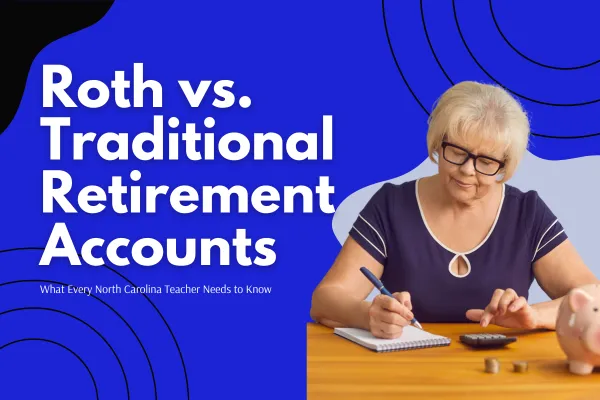
Roth vs. Traditional Retirement Accounts: What Every North Carolina Teacher Needs to Know
Roth vs. Traditional Retirement Accounts: What Every North Carolina Teacher Needs to Know
Choosing the right retirement account can feel overwhelming—especially when you’re balancing the unique benefits and salary structures of North Carolina’s public school system. If you’re like nearly 40% of educators, you might be unsure whether a Roth or Traditional retirement account is the best choice for your future. And that uncertainty could cost you thousands of dollars in taxes over your lifetime.
In this post, I’ll break down the key differences between Roth and Traditional accounts, why this decision matters more than you think, and how to avoid leaving money on the table as you plan for retirement.
What’s the Difference Between Roth and Traditional Retirement Accounts?
The main difference lies in when you pay taxes:
Traditional accounts (like 401(k), 403(b), 457(b), or Traditional IRA) let you contribute pre-tax dollars, which lowers your taxable income today. However, when you withdraw the money in retirement, you’ll pay taxes on both contributions and earnings.
Roth accounts (Roth 401(k), Roth 403(b), Roth 457(b), or Roth IRA) require you to contribute after-tax dollars. The big benefit? Withdrawals in retirement are tax-free, including the earnings.
Why Does This Matter for North Carolina Teachers?
Many NC teachers are part of pension systems and may receive Social Security benefits, which can push you into a higher tax bracket during retirement. That’s why choosing a Roth could be a powerful tool: paying taxes now at a potentially lower rate means tax-free withdrawals later when your income is higher.
For example, a Guilford County teacher earning $50,000 per year was originally contributing to a traditional account, thinking it saved her money. But after reviewing her full tax picture—including pension income—she realized she could save over $18,000 in lifetime taxes by switching to a Roth.
How to Decide Which Account is Right for You
To make the best choice, you’ll want to factor in:
Your current tax bracket versus your expected tax bracket in retirement
How your pension and other retirement income affect your taxes
Whether your school district offers both Roth and Traditional options (most do!)
Many plans also allow you to split contributions or switch between account types annually, so you can adjust your strategy as your financial situation changes.
Don’t Just Take My Word for It — Watch the Replay!
If this sounds complicated, you’re not alone. That’s why I hosted a detailed Retirement Ready live session specifically for North Carolina teachers to break down Roth vs. Traditional retirement accounts in plain language.
In this session, you’ll get:
Clear explanations of tax implications
Real-life teacher stories and savings examples
A FREE Roth vs. Traditional comparison chart tailored for NC educators
🎥 Watch the full replay here: https://www.youtube.com/watch?v=IzKUUuzNk6Q&list=PLXzoQDCW-CDhtL4a2XZ-03MoZaWB_kIYX&index=18
Join Us Live Every Wednesday!
Want to dive deeper and get your questions answered live? Our Retirement Ready livestream happens every Wednesday at 7 PM EST—just for North Carolina teachers.
👉 Register here to attend live: https://learn.dondaves.net/retirement-ready-lead-capture-page
Final Thoughts
Choosing between Roth and Traditional retirement accounts is one of the most important decisions you can make for your financial future as a teacher. Don’t leave your retirement to guesswork or generic advice—get the clarity and tailored insights you deserve.
Feel free to drop your questions in the comments or reach out for a free 15-minute consultation to review your specific situation.
Here’s to a smarter, more empowered retirement journey!
